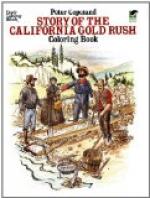General Fremont, the “path-finder,” who could easily find the best way through a wilderness and could make maps or roads for others to follow him, is a striking figure in California history. He made three exploring trips to this coast, Kit Carson, the famous hunter and trapper, being his guide and scout. From the Oregon line to San Diego, Fremont knew the country. He was a brave Indian fighter and helped to capture California from Mexico. Fremont was appointed governor of the new territory by Stockton, and was the first senator from California representing the state in Congress. In 1848 Fremont sent a map of the country to Congress, and on it named the strait at the entrance to San Francisco Bay the Golden Gate. He was, therefore, the first to use this beautiful name now known the world over. His wife, Jessie Benton Fremont, is still living in Los Angeles.
Commodore Sloat, who raised the American flag at Monterey, and Commodore Stockton were United States naval officers who helped to conquer the Mexican and Indian forces with the aid of Fremont and General Kearny. These four men won the land of gold for the Union.
General John Bidwell, another “path-finder,” who in 1841 led the first party of white men over the Sierras, lived to be over eighty years of age. He saw the state, once a wilderness where naked Digger Indians chased elk and antelope, grow to a pleasant land of orchards and vineyards, of great cities full of people. General Bidwell was for a time in Sutter’s employ, and surveyed nearly all the large ranches and the roads in early days. All his life he planted trees and built roads, and at his great Rancho Chico is one of the largest orchards in the state. Part of his life-work was to help a tribe of savage Indians to be good American citizens, and as one of the fathers of California he should always be remembered.
Many notable names appear in the days when the finding of gold brought this shore of the Pacific Ocean before the eyes of the world. Among these are Gwin, who was chosen senator with Fremont; Larkin, widely known as the first and last American Consul to California and for his accounts of the gold discovery; and Halleck, first secretary of the state and afterward General Halleck.
The streets of San Francisco honor some of the citizens of 1848 and 1849: Geary, the first postmaster; Leavenworth and Hyde, the first alcaldes or mayors; Van Ness, Broderick, Turk, and McAllister, recalling prominent men of those days. Spanish families like Sanchez, Castro, Noe, Bernal, and Guerrero had also a place on the city map. Indeed, every town has some native Californian names in and around it.
Don Victor Castro, said to be the first white child born in San Francisco, died lately at San Pablo in the house he had built sixty years ago. He was called the last of the Spanish grandees, those dons who, before the Gringos came, had estates that stretched miles away on every hand, and thousands of cattle with many Indian servants. Don Victor built and ran the first ferry across San Francisco Bay.




